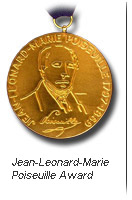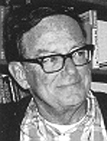|
||||
|
||||
|
Giles Cokelet was awarded the Poiseuille Medal during the 10th International Congress of Biorheology. Dr.Cokelet brought to Biorheology a body of investigations into the mechanics of blood flow in the microcirculation distinguished by the thoughtfulness and the outstanding scientific accuracy with which they were carried out. Among his more important works are
manuscripts dealing with the question of a yield stress for mammalian
blood, the Fåhraeus and Fåhraeus-Lindqvist Effects, and most
recently, papers dealing with microvascular hydrodynamic resistance and
cell distribution in microvascular networks. Dr. Cokelet pointed out
that many of the claims of other investigators that there exists a small
yield stress were unreliable because of artifacts in their measurements.
In carefully thought-out and executed experiments, Dr. Cokelet explored
the Fåhraeus Effect in small tubes and quantitated its dependence
on tube diameter, hematocrit and flow rate. The work in vitro then led
him to consider the application of the Fåhraeus and Fåhraeus-Lindqvist
Effects to the living microcirculation. He determined from in vitro experiments
how red cell distribution at bifurcations was affected by flow and vessel
geometry. To do this, he pioneered methods for the construction of tiny
bifurcations having diameters from 20 to 100 µm diameter. Then,
he applied the knowledge of single vessel experiments to a microvascular
network and was able to show quite conclusively that non-uniform distribution
of flow at microvascular bifurcations tends to induce a difference in
the overall velocity of the red cells traversing the microvessel network
compared to that of the plasma. The mean discharge hematocrit of the
network will be less than the hematocrit of the feeding and draining
vessels, and mean vessel hematocrit will be lower than the inflow arterial
hematocrit. This effect was termed the Network Fåhraeus Effect.
Most recently there has been work on white cell hemodynamics, in particular
studies of the interactions of leukocytes with the endothelium and their
effect on flow resistance and drag forces in capillary and postcapillary
vessels.
|
The International Society of Biorheology © Copyright 2004

